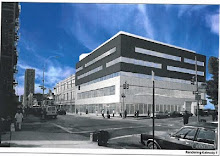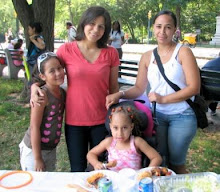 In April we hosted a ribbon cutting event which opened our offices to the public and included a ceremony acknowledging the contributions of five pioneer Latino women leaders. Later on, during the summer, we immersed ourselves in the Promise Neighborhood movement to bring wraparound services to at risk children with the aim of reducing the achievement gap of students and which calls for solutions to strengthen the East Harlem community that they call home. More than a dozen organizations collaborated with us in this major effort. Unfortunately Sinergia’s was not one of the winning submissions, but our hope is to leverage the connections we initiated to help lift educational barriers in El Barrio. A follow-up community educational forum was held in November to engage parents, educators and key stakeholders in finding solutions to the problems that are besetting Latino youth, who are at the bottom of education and employment indicators. We hope this will be the first of further ongoing discussions.
In April we hosted a ribbon cutting event which opened our offices to the public and included a ceremony acknowledging the contributions of five pioneer Latino women leaders. Later on, during the summer, we immersed ourselves in the Promise Neighborhood movement to bring wraparound services to at risk children with the aim of reducing the achievement gap of students and which calls for solutions to strengthen the East Harlem community that they call home. More than a dozen organizations collaborated with us in this major effort. Unfortunately Sinergia’s was not one of the winning submissions, but our hope is to leverage the connections we initiated to help lift educational barriers in El Barrio. A follow-up community educational forum was held in November to engage parents, educators and key stakeholders in finding solutions to the problems that are besetting Latino youth, who are at the bottom of education and employment indicators. We hope this will be the first of further ongoing discussions. Our collaborations with the PACER Center’s National Family Advocacy Support and Training Program led Sinergia to pilot four of the program curriculums for parents and translate them into Spanish. The sessions were conducted bilingually at the height of one of the worst snow storms of the year in February and despite that were extremely well attended. This past month we also partnered with the Healthy Families University Settlement Society of NY on a proposed project to help improve the outcomes for parents with intellectual disabilities and their infants, toddlers and young children. We are especially pleased about our relationship building with the Association to Benefit Children.
On the technology front, Sinergia was selected as one of eight Parent Training and Education Centers and Community Parent and Resource Centers to be part of the Technology Leadership Initiative funded by the Office of Special Education Programs of the U.S. Department of Education (OSEP). This initiative will increase our technology building capacity to serve people with disabilities and their families. We are also making full use of the social networks by disseminating valuable information through an active Facebook page and a blog as well as a monthly eNewsletter which is also translated into Spanish and reproduced in hard copy for those families without computers. And through the generosity of IBM and the PACER Center, Sinergia received 10 Young Explorer Computers (pictured) and software which were distributed to seven early childhood centers in the area.
Myrta Cuadra-Lash, Sinergia’s executive director, has been asked to speak on several occasions, including at a forum on culturally competent programs sponsored by the NYC Department of Health and Mental Hygiene at Fordham University, and at the NYS Office for People With Developmental Disabilities - Women of Excellence event. In addition she was interviewed in July by the Harlem World radio program on Sinergia’s Promise Neighborhood submission.
This year we bid a fond farewell to OPWDD Commissioner Diana Ritter Jones, Assoc. Comm. Kathy Broderick and Dr. Hugh Tarpley, Director of Metro DDSO, and our own Rocio Mendez, an Intake Specialist who is pursuing her acting career with the NJ Shakespeare Theatre. We wish them all the best in their future endeavors.
 Last but not least, our recap of 2010 wouldn’t be complete without mentioning some of our fun activities, and our annual summer family picnic in Central Park was a lively example of that, with over 250
children and parents attending. Then in December Sinergia held its
annual Christmas celebration at Lincoln Center’s Julliard School -- now
in its 25th year! The Department of Sanitation of the City of NY (Unit
M7, below right) has been our ongoing sponsor, and they helped make this the best one
yet. The large space was filled to capacity and overflowing with the
joy of children playing, singing and anticipating
Last but not least, our recap of 2010 wouldn’t be complete without mentioning some of our fun activities, and our annual summer family picnic in Central Park was a lively example of that, with over 250
children and parents attending. Then in December Sinergia held its
annual Christmas celebration at Lincoln Center’s Julliard School -- now
in its 25th year! The Department of Sanitation of the City of NY (Unit
M7, below right) has been our ongoing sponsor, and they helped make this the best one
yet. The large space was filled to capacity and overflowing with the
joy of children playing, singing and anticipating  Santa’s arrival. All
the happiness and laughter in the room rejuvenated our commitment to our
mission: that of helping children, adults and families to realize
meaningful, fully inclusive lives. Sinergia wishes to thank all our
funders, particularly the NYS Office for People with Developmental
Disabilities (OPWDD) and the U.S. Department of Education’s Office of
Special Ed Programs (OSEP) as well as all our friends, families and
staff for their unwavering support.
Santa’s arrival. All
the happiness and laughter in the room rejuvenated our commitment to our
mission: that of helping children, adults and families to realize
meaningful, fully inclusive lives. Sinergia wishes to thank all our
funders, particularly the NYS Office for People with Developmental
Disabilities (OPWDD) and the U.S. Department of Education’s Office of
Special Ed Programs (OSEP) as well as all our friends, families and
staff for their unwavering support.








































